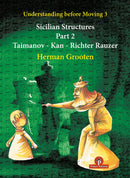Description
Chess BooksUnderstanding before Moving 3: Sicilian Structures Part 2 by Herman Grooten
Taimanov - Kan - Richter Rauzer
The first volume dealt with the Najdorf and Scheveningen variations, and it is now time to pay attention to three other extremely popular systems: the Taimanov, Kan and Richter-Rauzer variations. After careful consideration within the Thinkers Publishing team, we decided that it made sense to group these variations together. In particular, the first two are closely related and share the feature that, in both cases, Black plays …e7-e6 and …a7-a6 at an early stage. They typically have the idea of retaining more options for their king’s bishop by postponing …d7-d6 (or even omitting it entirely.) The bishop may go to b4 or c5 in different lines.
The Richter-Rauzer is, in theory, just one of the possible developments from a Classical Sicilian. We have already dealt with a few games that started with the Classical and where Black shortly played …e7-e6; and 6.Bc4 (the Sozin variation) was rightly treated within the Scheveningen pages. However, it is clear that White’s most popular counter, the Richter-Rauzer variation (6.Bg5) deserves separate attention.
While looking at the variation structure for the Kan and Taimanov and deciding on which model games to use, I noticed a lot of possible transitions to the ‘Hedgehog’ structure. The key features are white pawns on e4 and c4, and at least four black pawns on a6, b6, d6 and e6. This structure is ideally suited to the task of playing for a win as Black, because of the very complicated middlegames that arise. (And one often needs complicated middlegames to have a better chance of ‘converting’ a rating advantage!) The ‘Hedgehog’ is definitely a structure rather than a variation, but it has such a distinctive character of its own that I chose to examine it first in chapter 2. This simplifies later discussion of the Taimanov and Kan variations by removing the need to discuss every possible way of entering a Hedgehog structure.
A few further comments regarding the Hedgehog. This way of setting up the pieces simply on the back two rows, with four ‘spikes’ directly in front, has been used by many strong players, including world champions. (That is because it can also be used in various other openings, including the Symmetrical English or Queen’s Indian.) As for myself, this setup has long been a favorite, and from my very first acquaintance with the structure I was immediately mesmerized by the possibilities for rich strategic play. It is fascinating to see how strong players manage to outwit their – sometimes equally esteemed – opponents even while staying so far within their own territory. In that respect, a parallel may be drawn with the famous “Catenaccio” style in which the Italian national football (soccer) team used to play.
Catenaccio is the Italian word for ‘chain’ and the style is associated with a well-organized defense, to neutralize the attacks of the opponents before they get started. The moment the opponent finally tries to get inside the fortifications, a counter-attack will come with impressive speed. Thus it is also with the Hedgehog in chess. Black stays on the back few rows and White, who has more space, sometimes falls into a trap. When the position suddenly opens, very often the small latent weaknesses in White’s camp will prove to be his undoing. In this book I give a schematic representation of the plans developed both sides have developed over the years, illustrated through model games. Very often, authors will say that they ‘could write a whole book’ on one of their topics; in this case, the wealth of strategic play in the Hedgehog prompted me to do just that. In ‘Key Concepts of Chess – The Hedgehog’, the first in a new series (by the same publisher) you will find this fascinating beast examined in even greater detail, should you be interested.
In each chapter, the majority of the space is taken up by discussion of model games. This is exactly what I also did in previous volumes of this series and represents a core tenet of the Understanding Before Moving philosophy. The main idea is that the reader can thus increase his understanding of practical middlegames that actually arise from the variation in question, and in so doing also develop a better feel for how to handle the opening responsibly.
Paperback, 424 pages, Thinkers Publishing
Payment & Security
Your payment information is processed securely. We do not store credit card details nor have access to your credit card information.


